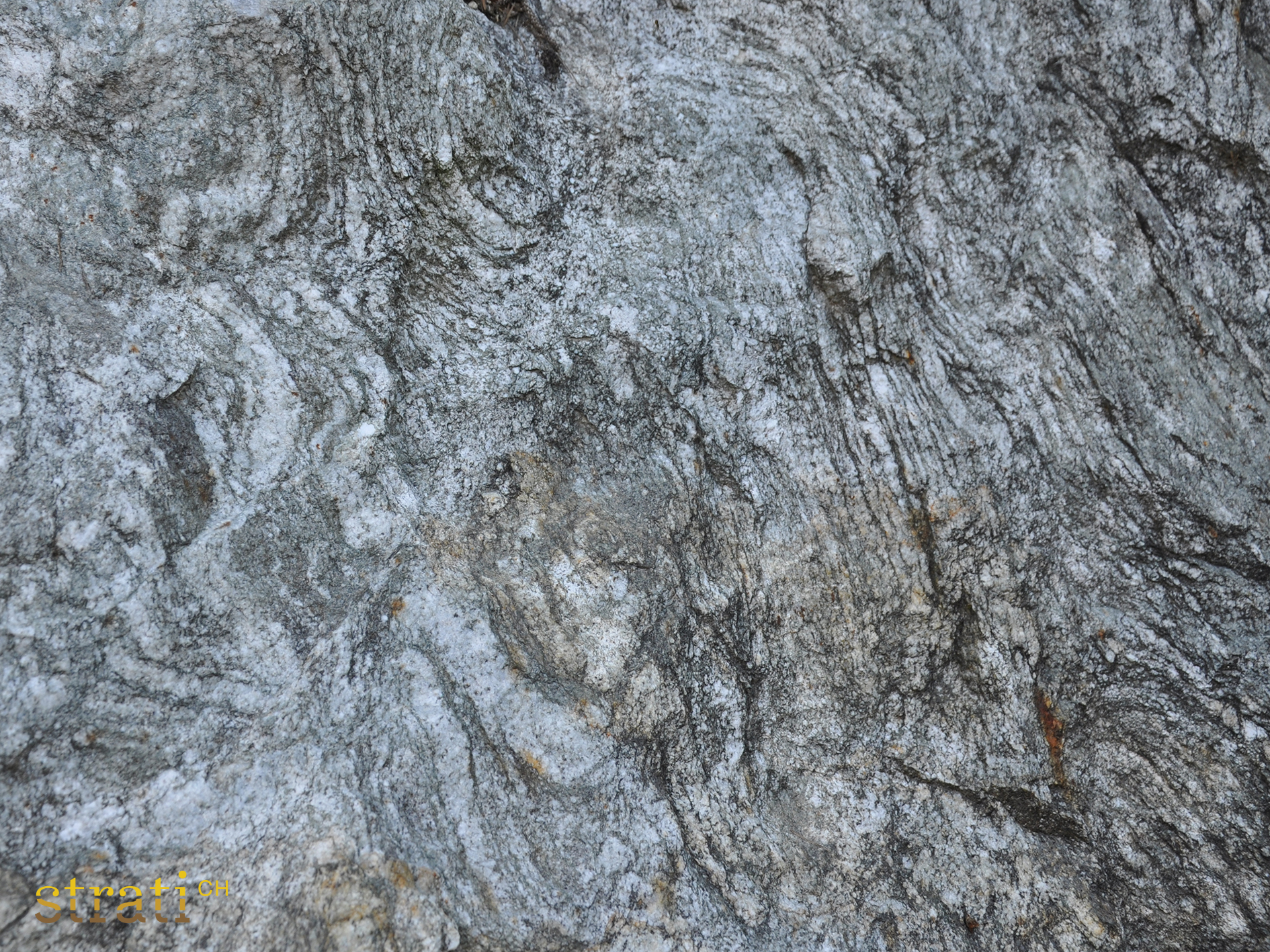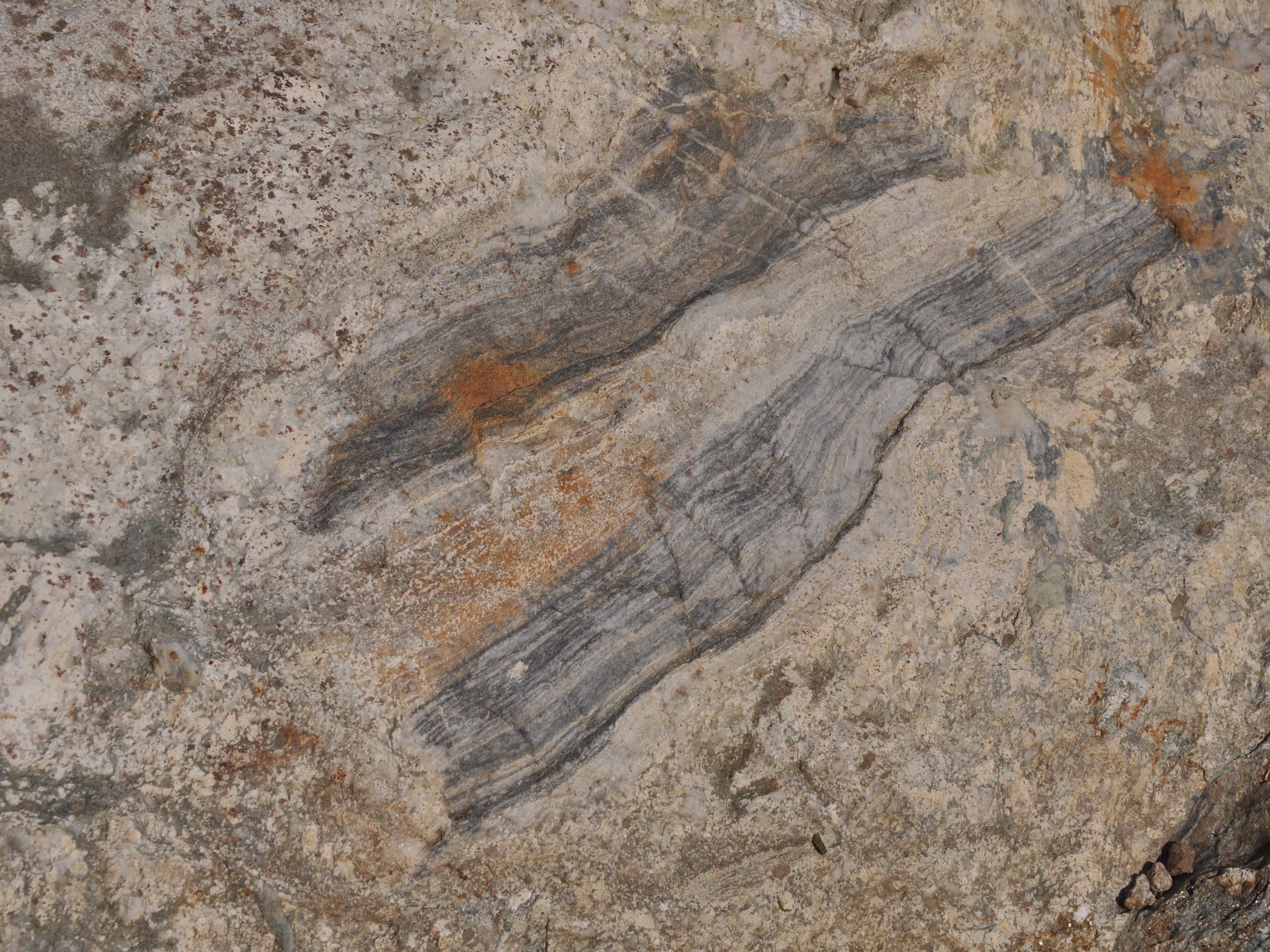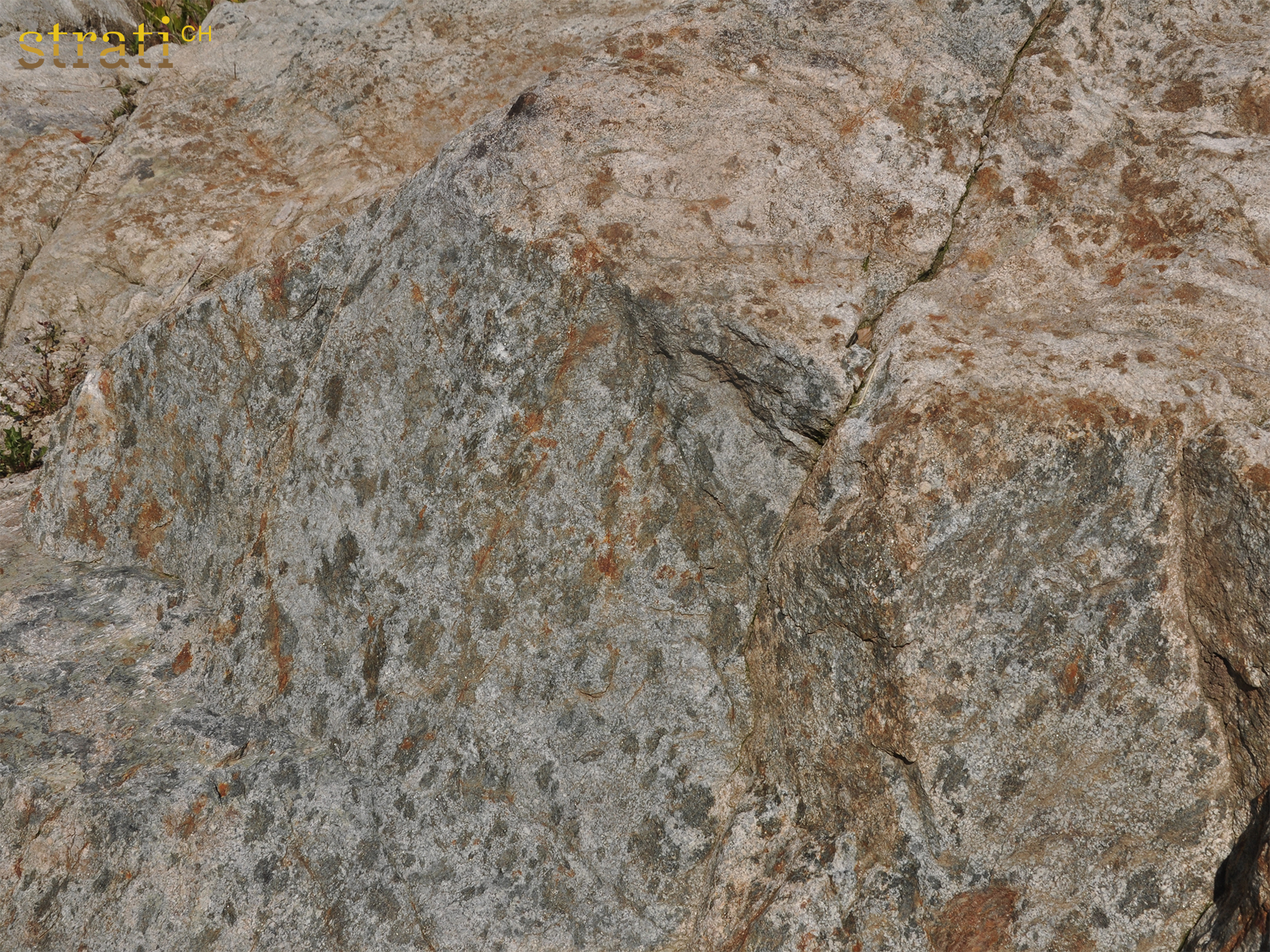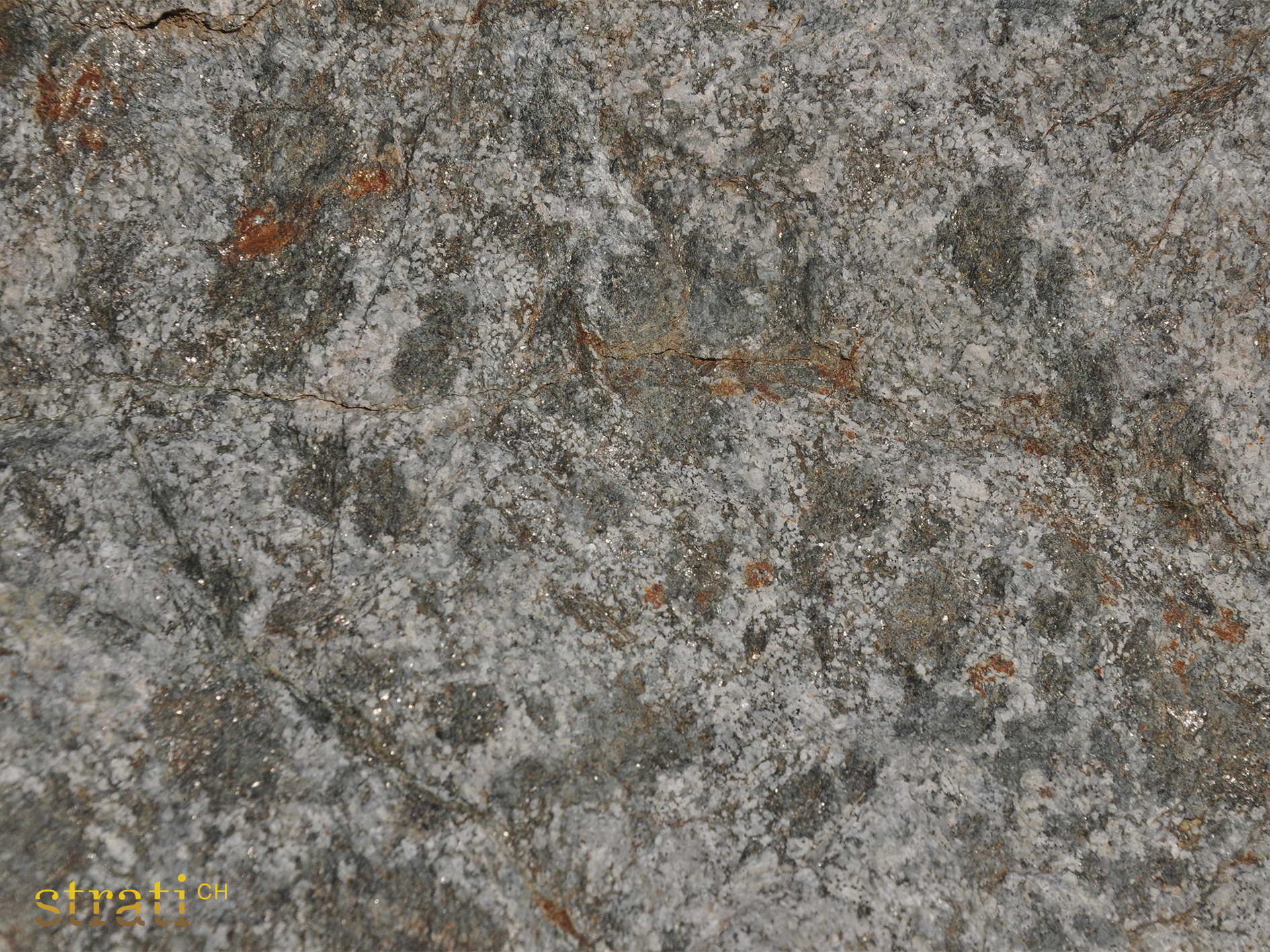Innertkirchen-Migmatit
Retour à Massif de l'AarReprésentation et statut
- Index
- GM-I
- Couleur CMYK
- (0%,24%,30%,2%)
- Couleur RGB
- R: 250 G: 190 B: 175
- Rang
- Formation lithostratigraphique
- Usage
- Ce terme est en usage.
- Status
- terme informel
Nomenclature
- Deutsch
- Innertkirchen-Migmatit
- Français
- Migmatite d'Innertkirchen
- Italiano
- Migmatite di Innertkirchen
- English
- Innertkirchen Migmatite
- Origine du nom
- Variantes historiques
-
Innertkirchener Gneiss (Baltzer 1888 S.31), Innertkirchnergranit (Sauer 1900, Lotze 1914, Hügi 1956), Innertkirchner Granit, Innertkirchner-Granit, Innertkirchengranit (de Quervain 1969), Innertkirchner-Kristallin (Labhart), Innertkirchen-Kristallinzone, Innertkirchen-Lauterbrunnen Gneiss Complex (Berger et al. 2017), Innertkirchen-Lauterbrunnen-Gneiskomplex
Description
- Description
-
Schollenmigmatit mit granodioritischer Grundmasse und Schollen von Altkristallingesteinen (dunkler Paragneis, Erstfeldergneis, Marmor, Amphibolit). / Meist helle, heterogene granitoide Gneise (Metasedimente), oft migmatisch, häufig Einschlüsse von Biotitgneisen, basischen bis ultrabasischen Gesteinen (Amphibolite) und Marmoren.
Hiérarchie et succession
- Unités hiérarchiquement subordonnées
- Unités sus-jacentes
Âge
- Âge au sommet
-
- Ordovicien
- Âge à la base
-
- Précambrien
Géographie
- Extension géographique
- Nördliches Aarmassiv, von Innertkirchen nach Urbachtal im Westen und ins Gadmental im Osten. Maximale Beite von 4,5 km an der Grimselstrasse.
Paléogéographie et tectonique
-
- Socle polycyclique anté-varisque de l'Helvétique
- Termes génériques
- Type de protolithe
-
- plutonique
- Métamorphisme
- polycyclique
- Remarque sur le métamorphisme
-
Bei der kaledonische Gebirgsbildung entstanden und durch die variszische und alpine Orogenese weiter modifiziert.
Références
- Définition
-
(1888) :
Das Aarmassiv (mittlerer Teil) nebst einem Abschnitt des Gotthardmassivs, enthalten auf Blatt XIII. Beitr. geol. Karte Schweiz 24/4. 204 Seiten
S.31: lnnertkirchener Gneiss. Besitzt granitische Textur. Ist in Bänken von mehreren cm. Dicke abgesondert. Muscovit zurücktretend, graugrünlich, in einzelnen Schuppen eingestreut. Ortho- und Plagioklas. (...) Dieser Gneiss ist besonders an der Gränze der Sedimente in der Gegend von Innertkirchen (z. B. gleich hinter Hotel du Hof), im Urbachthal, im Gadmenthal, bei Ferrichstätten, am Wendengletscher entwickelt.
- Révision
-
(2017) :
Geological Map of the Aar Massif, Tavetsch and Gotthard Nappes. Geological Special Map 1:100'000, Explanatory Notes 129
p.30: The Innertkirchen-Lauterbrunnen Gneiss Complex is dominated by a cordierite-bearing migmatitic gneiss derived from metasedimentary protoliths (Fig. 2, RUTISHAUSER 1973 a, b). The local different aspect of the migmatite led to the description of some biotite-plagioclase gneiss as “Orthogneis” or even as granitic intrusions (HUGI 1922). The migmatitic rocks contain abundant enclaves of marble, calcsilicate and amphibolite (Fig. 3). Often the original aspect of the rock obscured by strong deformation, particularly in zones where brittle deformation alternates with phyllitic shear zones (ABRECHT 1994).
The leucocratic members of the migmatite always contain variable amounts of cordierite (mainly represented by the retrograde alteration product “pinite”, a mixture of muscovite and chlorite) indicating anatexis at low-pressure /high-temperature conditions (RUTISHAUSER 1973 a). The timing of the cordierite-dominated anatexis and its relation with the Gastern Granite is a matter of debate (RUTISHAUSER & HÜGI 1978, OLSEN et al. 2000, HETTMANN et al. 2009). SCHALTEGGER(1993) showed an Ordovician U/Pb zircon age in the Innertkirchen-Lauterbrunnen Gneiss Complex, which was interpreted as the time of migmatisation. OLSEN et al.(2000) obtained Variscan U/Pb zircon ages in local leucocratic melt domains in the Innertkirchen-Lauterbrunnen Zone, but they left it unanswered whether the dated melts are intrusive or represent in-situ partial melts. More recent U/Pb ages on zircons infer also partial melting of the Innertkirchen-Lauterbrunnen Zone in the late Variscan (HETTMANN et al. 2009). The main characteristics of the Innertkirchen-Lauterbrunnen Gneiss Complex (among other the typical occurrence of cordierite) points to a connection with the anatectic rocks of the “Série de Fully” further to the west in the Aiguilles-Rouges Massif (KRUMMENACHER 1959, VON RAUMER 1984 a, b, 1988) and dated by BUSSY et al.(2000) at 327±2 to 320±1 Ma (U/Pb on monazite in anatectic metasedimentary gneisses and metapelites, respectively). Xenoliths of the Erstfeld Gneiss Complex in the migmatite of the Innertkirchen-Lauterbrunnen Zone (LABHART 1977) suggest that rocks from the Erstfeld Zone could be the protoliths of the migmatites of the Innertkirchen-Lauterbrunnen Gneiss Complex (SCHALTEGGER 1993). A polycyclic partial melting could explain the ambiguous results of isotope dating.
-
Schaftelen-Marmor
- Name Origin
-
Schaftelen (BE), SW Gadmen
- Rang
- unité lithostratigraphique
- Statut
- terme local (informel)
- En bref
-
Lokalname für schollenartige, z.T. dolomitische Marmoreinlagerungen im Innertkirchen-Gneiskomplex.
- Age
- Paléozoïque




